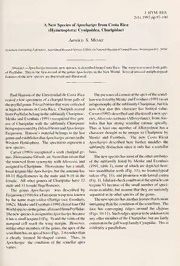
A new species of Apocharips from Costa Rica (Hymenoptera: Cynipoidea, Charipidae) PDF
Preview A new species of Apocharips from Costa Rica (Hymenoptera: Cynipoidea, Charipidae)
J.HYM.RES. 2(1), 1993pp.97-100 ANewSpeciesofApocharipsfromCostaRica (Hymenoptera:Cynipoidea,Charipidae) Arnold S.Menke SystematicEntomologyLaboratory.AgriculturalResearchService.USDA,c/oNationalMuseumofNaturalHistory.WashingtonD.C.20560 — Abstract. Apocharipshansoni,newspecies,isdescribedfromCostaRica. Thewaspwasrearedfromgalls ofPsyllidae. ThisisthefirstrecordofthegenusApocharipsintheNewWorld. Severalunusualmorphological featuresofthenewspeciesarediscussedandillustrated. PaulHansonoftheUniversidaddeCostaRica Thepresenceofcarinaeattheapexofthescutel- rearedafewspecimensofacharipidfromgallsof lumwaslistedbyMenkeandEvenhuis(1991)asan thepsyllidgenusTriozaForsterthatwerecollected autapomorphyofthesubfamilyCharipinae,butitis athighelevationsinCostaRica. Charipidsreared now clear that this character has limited value. fromPsyllidaebelonginthesubfamilyCharipinae. Carver(1992(describedandillustratedanewspe- MenkeandEvenhuis(1991)recognizedfivegen- cies,Alloxystacarinata(Alloxystinae),fromAus- eraofCharipidaewiththesubfamilyCharipinae tralia that has strong scutellar carinae apically. beingrepresentedbyDilytaForsterandApocharips ThusatleastonememberofAlloxystinaehasa Fergusson. Hanson'smaterialbelongstothelast characterthoughttobeunique toCharipinaeby genusandestablishesthatApocharipsoccursinthe Menke and Evenhuis. The new Costa Rican WesternHemisphere. Thespecimensrepresenta Apocharips described here further muddles the newspecies. subfamilydistinctionsinceitonlyhasascutellar Carver(1993)recognizedasixthcharipidge- boss. nus,ThoreauanaGirault,anAustraliantaxonthat Thenewspecieshasmostoftheotherattributes sheremovedfromsynonymywithAlloxysta,and ofthe subfamily listedby Menke and Evenhuis assignedtoCharipinae. Thoreauana hasasmall, (1991,table 1),someofwhicharedepictedhere: basaltergumlikeApocharips,buttheantennahas twomandibularteeth(Fig. 11), nofrontoclypeal 10-11 flagellomeres inthemaleand9-10inthe sulcus(Fig. 11),andpronotumwithlateralcarina female. All othergeneraofCharipidaehave 12 (Fig.1).Ididnotcheckconditonofthespiracleson maleand11 femaleflagellomeres. tergumVIbecauseofthesmallnumberofspeci- The genus Apocharips was described by mensavailable,butassumethattheyarenarrowly Fergusson(1986)foraEuropeanwaspnowknown separatedasinotherspeciesofthegenus. bythenametrapezoidea(Hartig)(seeEvenhuis. Thenewspecieshasanotherfeaturethatismore 1982). MenkeandEvenhuis(1991)listedfourOld intriguingthantheconditionofthescutellum. The Worldspeciesinthegenus,allrearedfromPsyllidae. face has converging ridges around the clypeus ThenewspeciesisassignedtoApocharipsbecause (Figs.10-11).Suchridgesappeartobeunknownin ithasasmalltergumI(Fig. 9)andtheveinsofthe anyothermemberoftheCharipidae,butarefairly marginalcell reachthewingmargin. However, commoninthegallwaspfamilyCynipidae.Thisis unlikeothermembersofthegenus,theapexofthe evidentlyaparallelism. scutellumhasanapicalboss(Figs.2-6)ratherthan a clearly formed M-shaped carina. Thus, in Apocharips the condition ofthe scutellar apex varies. 98 JournalofHymenopteraResearch Figs.1-6. MalethoraxfeaturesofApochahpshansoni,specimensfromVolcanPoas. 1.leftsideofthorax. 2,3. posterolateralviewofmetanotumshowingpoorlydefinedapicalboss(arrow).4-6,leftside,posterolateral,andrear viewsrespectively,ofmetanotumshowingmoreclearlydefinedapicalboss(arrow). Volume2,Number1,1993 99 Apocharipshansoni Menke,newspecies carinaapically,andthemetanotumlacksamedian carina.Theheadofhansoniinfrontalviewismore Blackexceptasfollows:scapeandflagellomere circular(Fig. 10)thanthatoftrapezoidea. Inthe I straw-colored; trochanters, apex of fore- and latter species the area below the eyes is more midfemora, foretibia, and foretarsomeres I-IV, elongateandnarrowedtowardthemandibles. The straw-colored (midtibia and tarsus similar but spur on the marginal cell is longer in hansoni, darker). Facewithnumerousparallelridgesbe- particularlyinth—emale. tween eye and mandible base (Figs. 10-11). Distribution. Knownonlyfrom elevations FlagellomeresI-IVoffemaleantennawithoutlin- between1950-—2500minCostaRica. eartyli,buttylipresentonV-XII;flagellomereII Etymology. This tiny wasp is named after shorterthanIII,proportionsoflengthoffirstthree PaulHansonwho, byrunningmanyMalaisetraps femaleflagellomeres:6:3.5:4. FlagellomeresI-III overaperiodofyears,hasprobablysampledthe ofmaleantennawithouttyli,buttyli presenton micro-HymenopterafaunaofCostaRicamorethor- remainingones(Figs. 1-2);flagellomereIsinuate oughlythananyoneelse. onouterside,longerthaneitherIIorIII,propor- tionsofflagellomeresI-III:8:5.5:6.Apexofscutel- ACKNOWLEDGEMENTS lumwithaweaktriangularbossthatisnotdelimited b6)y.caMreintaaen(oFtiugsm.w2-i3t)h.omrediinaconmplloentgietluydisnoa(lFicgasr.in4-a AmerTihceanmaMnuussecruimptofwNaasturreavliHeiwsetdorbyy,JNaemwesYoCrakr;peDnatveird, mf(Flimaggse.l3l,om6)e.reVeIIi.nFsetmuablfero1m.7mamrmginlaonlgc,elmlaalseslo1n.g5-a2s oaWgnadyhlAL,labmAoamreaSrtoiolcirsya,nanUEdnSDtDaoAvm,oildoWNgaiiscchkalilen,gItSnsyotsnitteuDtm.eaC,t.iGcaiTEnhneestivorimloclrlei-:- Tylpoensg..—Holotypefemale:CostaRica,Cartago tiquesaremuchappreciated. Prov., LaCangreja, 1950 m, March-May, 1992, LITERATURECITED MalaisetrapoperatedbyPaulHanson(inNational Museum of Natural History, Washington DC). Carver, Mary, 1992. Alloxystinae (Hymenoptera: Paratypemales(four):onesamedataasholotype; Cynipoidea:Charipidae)inAustralia. Invertebrate twomales,AlajuelaProv.,ParqueNationalVolcan Taxonomy6:769-785. Poas,2500m.May26,1991,exTriozasp.leafgall Carver, Mary. 1993. Australian Charipinae (Hy- onPhoebeorNectandra(Lauraceae),collectedby menoptera:Cynipoidea:Charipidae)describedbyA. Paul Hanson; one male, same locality and host, A.Girault.JournaloftheAustralianEntomological wSUeinplitlv.e2br2es,id1da9ed9po1ds,eciotCleoldsetcatienRdibtchyae,PaaMunuldsHtaehnoesoNdnae.tiPoIannrasaletcyMtpoues-s, EvenS(shopHcueyicimiesete,synHow3.2ip:tt4hHe3.rt,-ya4p4:1e.98dC2e.ysinginApaitsditoaunedsyaAnoldflonHxeayrwtsitsgiy*nnsaoeXnyysamtsnuds seumofNatura—lHistory. Charipinae).Spixiana5:19-29. Discussion. Apocharipshansonidiffersfrom Fergusson,N. D. M., 1986. Charipidae, Ibaliidae& theOldWorldspeciestrapezoideainanumberof Figitidae. Hymenoptera:Cynipoidea. Handbooks significantways. A.hansoni hasfacialridgesthat fortheIdentificationofBritishInsects8(lc): 1-55. convergeontheclypeus(Figs.10-11),notylionthe Kierych.E.,1979. NotesonthegeneraDilytaForster, tcthirhaameirvmaieefnnidgariuseotlaxnattarehtmlrbhieyoenesmsesmeedapotalnaraenattofsheltieanuhsggamlcenelu(sltFooiefngmleiselm.ruafem3lrs,e(o6(Fm)Fio;igtfgstr..hatep72rs)e-ae,z6po)fae,iezfdaoaeetineuadbrd.eleaesaI MenCcc31khay48een:n6,c94ikC.5plAh3oia.a-sinrt4dSdis.6ep,G0aial.,danyandpedtA:Hola.xlkyoneHssye.txwaytEosTvstghepieneodnchmaeiuesrei)oass.n,,on,fo1A1mD98eni97nln1c7ya.ltt(aaHeNtysoFumorrerteZsnh,otooeAsplrpmtoeee(gcrrHiiiayce,--is (Hartig), and the figures in the well illustrated menoptera:Cynipoidea). ProceedingsoftheEnto- descriptionoftrapezoideabyKierych(1979). A. mologicalSocietyofWashington93:136-158. trapezoidealacksfacialridges,themalehastylion allflagellomeres,thescutellumhasanM-shaped 100 JournalofHymenopteraResearch Figs.7-11. MalefeaturesofApocharipshansoni. 7,dorsalviewofscape,pedicelandflagellomeres1-3(and4). 8,dorsalviewofflagellomeres4-6enlargedfromrightantennashowninfig.7. 9,leftsideofabdomen. 10.11. viewofface,arrowpointstofacialridges.
